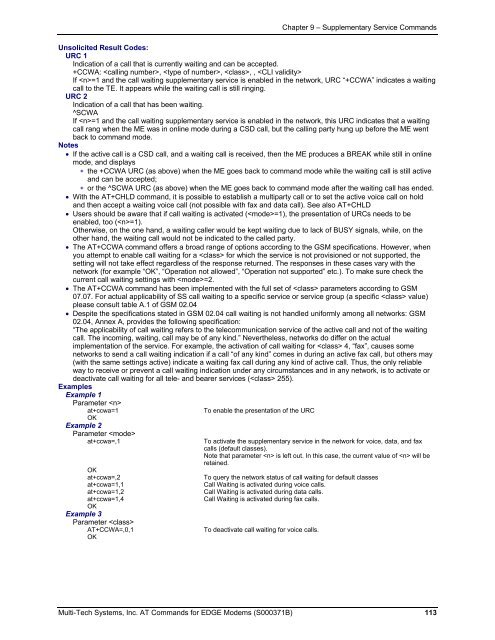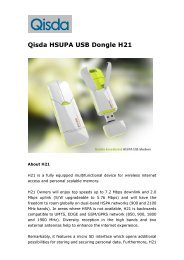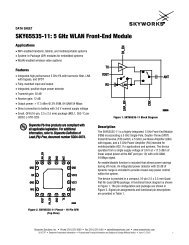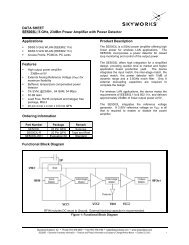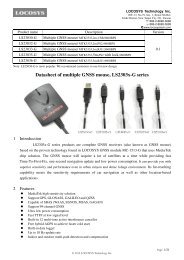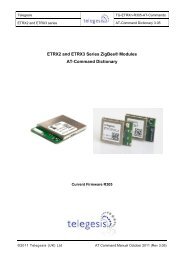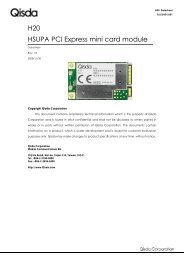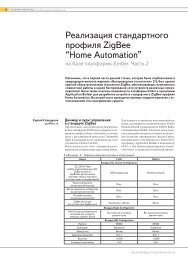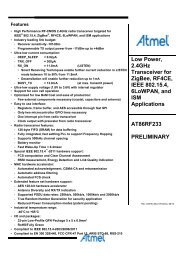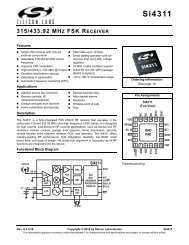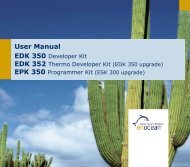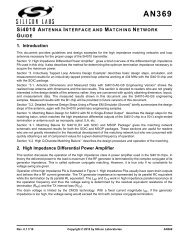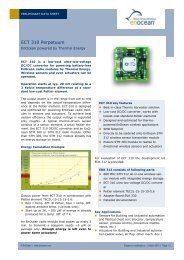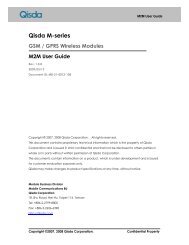AT Command Reference Guide for EDGE Wireless ... - wless.ru
AT Command Reference Guide for EDGE Wireless ... - wless.ru
AT Command Reference Guide for EDGE Wireless ... - wless.ru
You also want an ePaper? Increase the reach of your titles
YUMPU automatically turns print PDFs into web optimized ePapers that Google loves.
Chapter 9 – Supplementary Service <strong>Command</strong>s<br />
Unsolicited Result Codes:<br />
URC 1<br />
Indication of a call that is currently waiting and can be accepted.<br />
+CCWA: , , , , <br />
If =1 and the call waiting supplementary service is enabled in the network, URC “+CCWA” indicates a waiting<br />
call to the TE. It appears while the waiting call is still ringing.<br />
URC 2<br />
Indication of a call that has been waiting.<br />
^SCWA<br />
If =1 and the call waiting supplementary service is enabled in the network, this URC indicates that a waiting<br />
call rang when the ME was in online mode during a CSD call, but the calling party hung up be<strong>for</strong>e the ME went<br />
back to command mode.<br />
Notes<br />
• If the active call is a CSD call, and a waiting call is received, then the ME produces a BREAK while still in online<br />
mode, and displays<br />
∗ the +CCWA URC (as above) when the ME goes back to command mode while the waiting call is still active<br />
and can be accepted;<br />
∗ or the ^SCWA URC (as above) when the ME goes back to command mode after the waiting call has ended.<br />
• With the <strong>AT</strong>+CHLD command, it is possible to establish a multiparty call or to set the active voice call on hold<br />
and then accept a waiting voice call (not possible with fax and data call). See also <strong>AT</strong>+CHLD<br />
• Users should be aware that if call waiting is activated (=1), the presentation of URCs needs to be<br />
enabled, too (=1).<br />
Otherwise, on the one hand, a waiting caller would be kept waiting due to lack of BUSY signals, while, on the<br />
other hand, the waiting call would not be indicated to the called party.<br />
• The <strong>AT</strong>+CCWA command offers a broad range of options according to the GSM specifications. However, when<br />
you attempt to enable call waiting <strong>for</strong> a <strong>for</strong> which the service is not provisioned or not supported, the<br />
setting will not take effect regardless of the response returned. The responses in these cases vary with the<br />
network (<strong>for</strong> example “OK”, “Operation not allowed”, “Operation not supported” etc.). To make sure check the<br />
current call waiting settings with =2.<br />
• The <strong>AT</strong>+CCWA command has been implemented with the full set of parameters according to GSM<br />
07.07. For actual applicability of SS call waiting to a specific service or service group (a specific value)<br />
please consult table A.1 of GSM 02.04<br />
• Despite the specifications stated in GSM 02.04 call waiting is not handled uni<strong>for</strong>mly among all networks: GSM<br />
02.04, Annex A, provides the following specification:<br />
“The applicability of call waiting refers to the telecommunication service of the active call and not of the waiting<br />
call. The incoming, waiting, call may be of any kind.” Nevertheless, networks do differ on the actual<br />
implementation of the service. For example, the activation of call waiting <strong>for</strong> 4, “fax”, causes some<br />
networks to send a call waiting indication if a call “of any kind” comes in during an active fax call, but others may<br />
(with the same settings active) indicate a waiting fax call during any kind of active call. Thus, the only reliable<br />
way to receive or prevent a call waiting indication under any circumstances and in any network, is to activate or<br />
deactivate call waiting <strong>for</strong> all tele- and bearer services ( 255).<br />
Examples<br />
Example 1<br />
Parameter <br />
at+ccwa=1<br />
OK<br />
Example 2<br />
Parameter <br />
at+ccwa=,1<br />
OK<br />
at+ccwa=,2<br />
at+ccwa=1,1<br />
at+ccwa=1,2<br />
at+ccwa=1,4<br />
OK<br />
Example 3<br />
Parameter <br />
<strong>AT</strong>+CCWA=,0,1<br />
OK<br />
To enable the presentation of the URC<br />
To activate the supplementary service in the network <strong>for</strong> voice, data, and fax<br />
calls (default classes).<br />
Note that parameter is left out. In this case, the current value of will be<br />
retained.<br />
To query the network status of call waiting <strong>for</strong> default classes<br />
Call Waiting is activated during voice calls.<br />
Call Waiting is activated during data calls.<br />
Call Waiting is activated during fax calls.<br />
To deactivate call waiting <strong>for</strong> voice calls.<br />
Multi-Tech Systems, Inc. <strong>AT</strong> <strong>Command</strong>s <strong>for</strong> <strong>EDGE</strong> Modems (S000371B) 113


